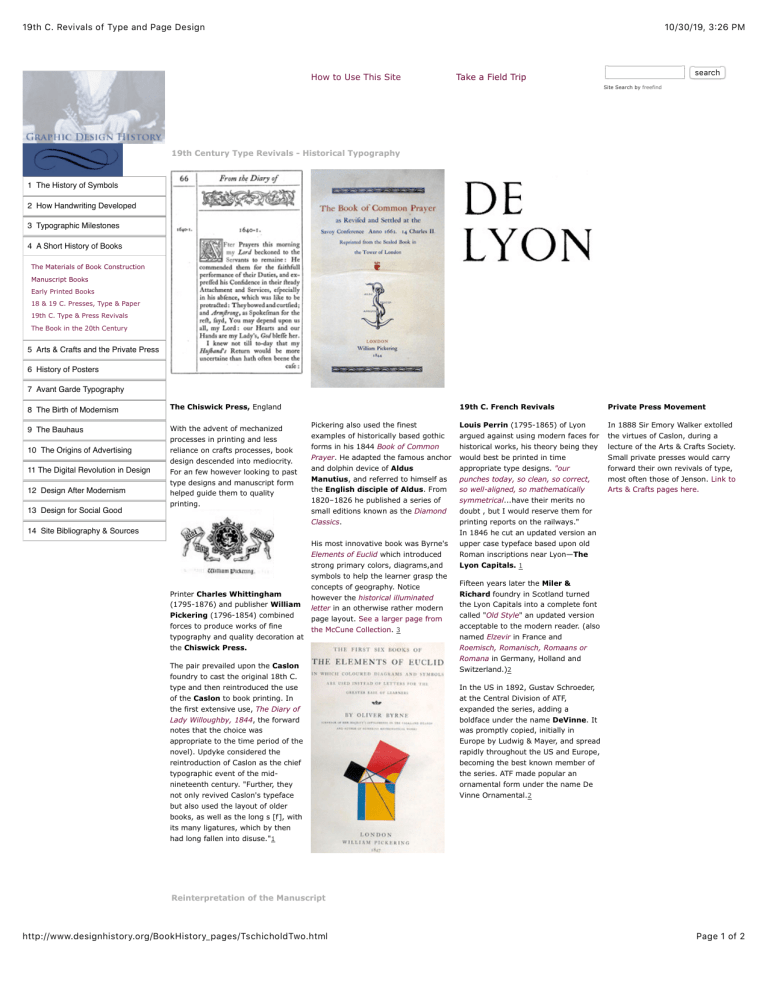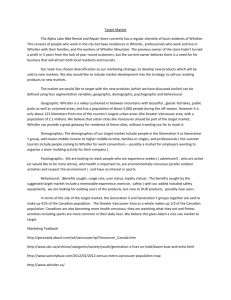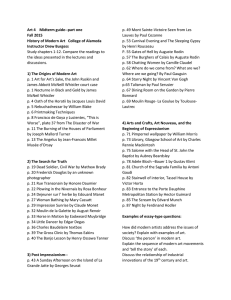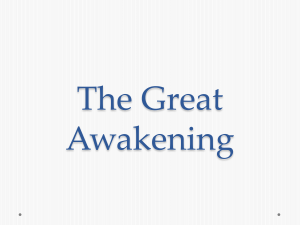
19th C. Revivals of Type and Page Design 10/30/19, 3(26 PM How to Use This Site search Take a Field Trip Site Search by freefind 19th Century Type Revivals - Historical Typography 1 The History of Symbols 2 How Handwriting Developed 3 Typographic Milestones 4 A Short History of Books The Materials of Book Construction Manuscript Books Early Printed Books 18 & 19 C. Presses, Type & Paper 19th C. Type & Press Revivals The Book in the 20th Century 5 Arts & Crafts and the Private Press 6 History of Posters 7 Avant Garde Typography 8 The Birth of Modernism 9 The Bauhaus 10 The Origins of Advertising 11 The Digital Revolution in Design 12 Design After Modernism 13 Design for Social Good The Chiswick Press, England With the advent of mechanized processes in printing and less reliance on crafts processes, book design descended into mediocrity. For an few however looking to past type designs and manuscript form helped guide them to quality printing. Pickering also used the finest examples of historically based gothic forms in his 1844 Book of Common Prayer. He adapted the famous anchor and dolphin device of Aldus Manutius, and referred to himself as the English disciple of Aldus. From 1820–1826 he published a series of small editions known as the Diamond Classics. 14 Site Bibliography & Sources Printer Charles Whittingham (1795-1876) and publisher William Pickering (1796-1854) combined forces to produce works of fine typography and quality decoration at the Chiswick Press. His most innovative book was Byrne's Elements of Euclid which introduced strong primary colors, diagrams,and symbols to help the learner grasp the concepts of geography. Notice however the historical illuminated letter in an otherwise rather modern page layout. See a larger page from the McCune Collection. 3 The pair prevailed upon the Caslon foundry to cast the original 18th C. type and then reintroduced the use of the Caslon to book printing. In the first extensive use, The Diary of Lady Willoughby, 1844, the forward notes that the choice was appropriate to the time period of the novel). Updyke considered the reintroduction of Caslon as the chief typographic event of the midnineteenth century. "Further, they not only revived Caslon's typeface but also used the layout of older books, as well as the long s [f], with its many ligatures, which by then had long fallen into disuse."1 19th C. French Revivals Private Press Movement Louis Perrin (1795-1865) of Lyon argued against using modern faces for historical works, his theory being they would best be printed in time appropriate type designs. "our punches today, so clean, so correct, so well-aligned, so mathematically symmetrical...have their merits no doubt , but I would reserve them for printing reports on the railways." In 1846 he cut an updated version an upper case typeface based upon old Roman inscriptions near Lyon—The Lyon Capitals. 1 In 1888 Sir Emory Walker extolled the virtues of Caslon, during a lecture of the Arts & Crafts Society. Small private presses would carry forward their own revivals of type, most often those of Jenson. Link to Arts & Crafts pages here. Fifteen years later the Miler & Richard foundry in Scotland turned the Lyon Capitals into a complete font called "Old Style" an updated version acceptable to the modern reader. (also named Elzevir in France and Roemisch, Romanisch, Romaans or Romana in Germany, Holland and Switzerland.)2 In the US in 1892, Gustav Schroeder, at the Central Division of ATF, expanded the series, adding a boldface under the name DeVinne. It was promptly copied, initially in Europe by Ludwig & Mayer, and spread rapidly throughout the US and Europe, becoming the best known member of the series. ATF made popular an ornamental form under the name De Vinne Ornamental.2 Reinterpretation of the Manuscript http://www.designhistory.org/BookHistory_pages/TschicholdTwo.html Page 1 of 2 19th C. Revivals of Type and Page Design 10/30/19, 3(27 PM (Coll.designhistory.org) Click here for larger view. Artists and the Book William Blake was an artist, book printer, author, mystic and poet —likely the first to be labeled with the term book artist. "His works would set the tone for later artists' books, connecting selfpublishing and self-distribution with the integration of text, image and form. All of these factors have remained key concepts in artists' books up to the present day."4 Blake's Songs of Innocence, the first of his illuminated books, was published in 1789. He used his own handwriting rather than set type, a technique more common in the middle ages. His illustrations often appeared alongside words in the manner of earlier illuminated manuscripts. In his, The Gentle Art of Making Enemies, 1890, (above) James Whistler (1834-1903) worked in double page spreads, carefully considering the use of white space against the text and ornaments. Whistler harkened back to early manuscripts with his use of gloss comments in the generous manuscript-like borders. In this case the device of gloss was used for Whistler to comments alongside the discussion of his famous lawsuit against the influential art critic John Ruskin. Whistler, a friend of Symbolist poet Stèphane Mallarmé, drew parallels between his work and music— frequently using terms such as nocturne or harmony in his painting titles. Visual balance was an integral part of Whistler's painting and printmaking and he carried that sensibility over to his book design. Whistler added his own sense of visual balance, an integral element in his painting and printmaking now carried over to his book's asymmetrical design. Footnotes 1 Berkeson, William, Readability and revival: the case of Caslon, Printing History. July 1, 2011. 2 Myfonts, Romana, Link 3 McCune Collection Link 4 The Notebook of William Blake, British Library on line Link Copyrights ©Designhistory.org 2011 http://www.designhistory.org/BookHistory_pages/TschicholdTwo.html For Permission Info click here Page 2 of 2




